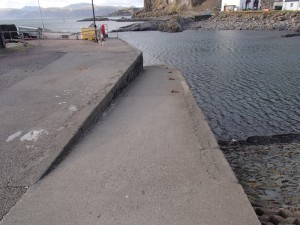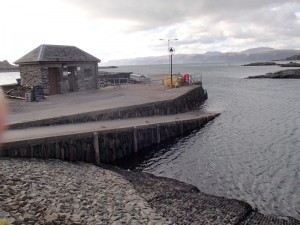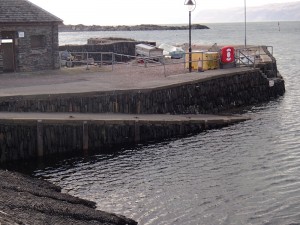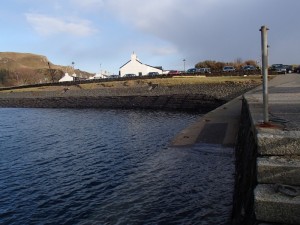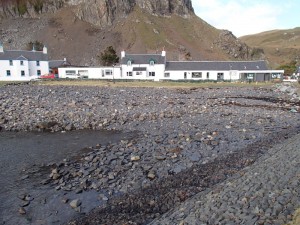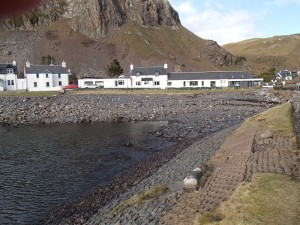 Well, there we are, we got there, just about a year after the first meeting. Not just a boat made, friendships too.
Well, there we are, we got there, just about a year after the first meeting. Not just a boat made, friendships too.
Uncategorized
Nearly there!

The skiff was turned again on Sunday – the rubbing strip and bungs having been added during the week by the busy fairies. Blocks for the oars were screwed on, and holes for the pins were drilled through the gunwhales. The rudder and footrests have been spirited away to warmer climes to be completed.
Bank Holiday Sunday painting
If there are enough strong folk around, we’ll (the royal we) turn the hull and pop on a second coat of ice-blue. Also the top strake needs a second coat of slate grey.
If not, the gunwhales need a second coat of slate grey – masking tape under the draining holes to catch the drips onto the lighter battleship grey. Also the thwarts need a second coat of blue, having masked off a new line about a foot outboard of the first one – paint over the grey
underneath.
Sorry I can’t be there again this week, but Seafari are putting me out to pasture on Tuesday so I’ll have more time to play. I’m being replaced by a younger model …
Sue
Battleship Grey done!
A couple of us finished the third, and final, topcoat of battleship grey this evening.
The ice blue on the thwarts still needs extending (two coats?). On Sunday, we need a final coat on the rudder, and then coats two and three need to be done on the gunwhales/shear and the hull. Nearly there!!!
Sorry I can’t be there again on Sunday as I shall be (gainfully) employed elsewhere.
Sue
Midweek painting session
Painting this Sunday
At last, the warmer weather has enabled three coats to be done in one week. Nick’s shed was positively tropical today!
Jobs for this coming Sunday:
1. Blades to be rubbed down and final coat of ice blue applied
2. Rudder to be rubbed down and second coat of ice blue applied
3. Earwigs, slaters and general mank to be removed from the boat (!)
4. First coat of topcoat (lighter grey) to be applied to the interior
Apologies, but I will be at the Temple of Mamon on Sunday. Rollers in plastic bags on the workbench, and seperate paint trays for each colour. Suck eggs!
Sue
Launching places for the skiff
With the skiff about to metamorphose from a project in a shed into a community asset there are a few practical issues to consider, not the least of which is where the boat can be launched.
When the Anstruther skiff came to visit they launched at Balvicar Boatyard, and in many ways this is the best and easiest option, particularly for visiting crews and boats. However, Seil is an island of two coasts, separated by the potentially troublesome waters of Cuan Sound. If people want to be able to use the boat regularly on the West side of the island – which is I suppose up to the rowers – it would be useful to have a place to launch on the West side.
Some of us had already discussed Ellenabeich and pretty much written it off because the slipway was too narrow and the launching spot in the SE corner of the wee harbour is too rocky with no vehicular access. The skiff is an unusual boat though, with a maximum beam of just 5ft 8 ins and is remarkably light for a 22ft boat.
With that in mind I went over to Ellenabeich to measure the slip. It is 6ft 5″ wide at the very top and a minimum of 6ft 6in wide for the remainder of its length. The metal mooring rings aren’t much of an obstruction, and it seems to me that with the right trailer or a dedicated launching trolley and a few fenders this would be eminently manageable and would allow crew or passengers to embark dry shod.
The other advantage of the pier at Ellenabeich is that it is one of the few places on Seil where the public have easy access to the shoreline. For open days, regattas etc this would be a big bonus, though it is likely that the Bay and the Sound on the East side would still be the favourites for all-weather racing or training.
These are just one person’s thoughts on the subject. If anyone else has any thoughts or ideas please leave a comment.
700 Years ago this Day
On 24 January 1313 King Robert Bruce granted in favour of Sir Dugald Campbell, Laird of Menstrie, Clackmannanshire, born at Lochow (Lochawe) 1259 or 1262 and son of Sir Cailean Mor a charter of the lands taken from the MacDougalls consisting of Kilcongen (Kilchoan), Degnish, Auchinaclosh (Kilninver) , Auchinsaule (Kilninver), Caddiltoune Ardmaddy), Garpynging (Kilninver), Ardincaple (Ardencaple), Ragray (Kilninver), Kilninver, Esgeallan (Kilninver), Clachanseilach (Clachan Seil), Leternacrosh (Kilninver), Scamadil (Scammadale), Kilveran (Kilninver), Letternamuck (Kilninver) and the isle of Toresay (Torsa), in exchange for providing a twenty six-oared galley equipped with men and victuals.
Seven hundred years later the following exchange took place between Eoghan o’ the Lang Skiff and Choinnich Sgarbheach, the Sage of Doune:
Eoghan: I don’t know what the MacDougalls had done to deserve having their lands taken away and Sir Dugald had a few years earlier backed King Edward against the Bruce. It all goes to show the Campbells usually come up smelling sweet. Glad (in a way) that my great great great Grannie was one.
Choinnich: It was in the Pass of Brander that the MacDougalls learned a lesson taught by Robert the Great, with young Colin Campbell at his shoulder, to the effect that EDW I was a bad person. That is what they did and some people in Argyll have yet to forgive. Now, while it is the case that the Campbells, as signatories of The True Solemn Oath and Covenant, found themselves opposed to the heirs of Marjorie Bruce (who would have done far better to marry young Colin of Argyll rather than Walter Stewart), and thus sided with a wee bit Gairman Lairdie, the MacDougalls appear to have escaped without a blemish on their estates, although their character is well known throughout Argyll. Now I find myself asking, ‘What is this about taking lands off the MacDougalls? There is surely only MacCallum Mhor that has the power to do such a thing, and himself short on the powers that were once his to command. If it is not Cleann Caimbeul that is doing this thing then it has no businness to be done for we alone can do such a thing and end up smelling of roses, even if they be the Floo’ers o’ Edinbro. Stand proud in your Campbell heritage, my kinsman.
Eoghan: Ach, ye have an answer to evrytheeng, ma pretty Freen!
The charter was granted less than 50 years after the conflict between the emerging Scottish kingdom and Norway was resolved at the Treaty of Perth in 1266, which was prefigured by the Battle of Largs in 1263. The early Scottish kings were finding it a hard job coming to grips with the people of the islands, who retained fond memories of the autonomy previously enjoyed and of course were themselves partly of Norse ancestry. The Bruce operated a policy of consolidating his grip on the main land by building castles and installing suitable tough guys to control the unruly Gaels.
It’s interesting to see the notorious political flexibility of the well-named Campbells (literally Cam Beal – crooked mouth, not of course referring to a physical attribute) to the fore so early in the history of our nation.
Sea power was vital to ruling the islands in the pre-road period. Providing a galley of 26 oars was a major endeavour justifying the grant of a huge tract of land, although one can imagine that retaining control would also take some effort. There would have been a big tribe of angry MacDougalls to contend with for a start.
I’ve tried to identify the various estates involved, extending from Loch Awe in the East to the North shore of Loch Melfort on the South along to Degnish Point, then the West boundary running up the middle of Seil Sound to Clachan Seil, but including Torsa Island with the Castle of the Dogs and a North boundary running somewhere to the North of present-day Kilninver along to Loch Awe again.
The anomaly is the inclusion of Ardincaple at the North end of the Isle of Seil. Literally Ard na gCapull, the “point of the horses” this may refer not to real horses but to the black rocky reefs and breaking waves off the point, resembling in the mind of the poetic Gael wild horses. Ardincaple is the site of Ardfad Castle, the seat of the MacDougalls and awarding this to the Campbells would have been a serious provocation, especially as the remainder of the island seems not to have been included. Perhaps that was granted to another of the Campbell knights.
Regarding the actual galley one can assume that there would have been thirteen thwarts or benches, two oarsmen on each and “rooms” of about a metre in length, suggesting a hull length of at least seventeen metres, fifty six feet, if we allow a couple of metres at each end. The image at the top of this post has seventeen oar ports, thirty four oars, and the biggest galleys seem to have been forty oared, but there’s a lack of archaeological evidence and it’s always possible that once the charter had been granted the galley didn’t actually materialise.
At least it’s not snowing (yet)
We’ll be back to work today, sorting out the final thwart positions, deciding on the position of the supporting beams and fixings.
The wood for these parts has been machined but will of course benefit from the efforts of our specialist sanders as always.
While working away we can contemplate our futures as stars of stage and screen. We’ve made a good start, featuring in a major national newspaper and it’s rumoured that the BBC are next in line.
Chris Spotted
Just after Hogmanay phones started ringing on the shores of Seil Sound as recovering residents tried to find out exactly what had just passed their windows. Those of us in the know were able to tell them that the long double-ended boat now speeding under the bridge at Clachan Seil was Chris o’Kanaird enjoying his first trip of 2013. He (she?) had come over from Anstruther for the holidays.
The long-awaited Kilmelford Rowing Club has now been formed and hope to start on their kit later this month. Babs and Alan kindly brought Chris round to Loch Melfort today and the weather allowed some of the team to get out on the water. We had a good few circuits of the top end of Loch na Cille and got a nice introduction to skiffing.
Personally the thing that struck me most was finding how little resistance there is as the skiff gathers speed. There was probably less effort involved than in sculling about in a much smaller dinghy. One minute we were at the edge of the moorings, the next right up at the head of the loch, so fast that the photograph Iain B took of us is a wee bit blurred.
I’ve been left mad keen to get our own skiff on the water and slightly frustrated that we haven’t managed to get our remaining wood machined yet, so it will be another week before construction resumes.


